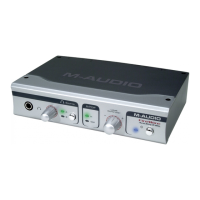This way, when you play back a track that you’ve just recorded, you’ll hear it in exactly
the same way as you did while recording. This is very useful for both the artist and the
producer, and is generally better for judging the performance than having to shift your
perception to listening to the track without an effect or with a different effect (such as one
provided by a software plug-in).
NOTE: If your effects unit does not have a S/PDIF input (yet does have a S/PDIF
output), you may substitute the FireWire Audiophile line out 3/4 for the S/PDIF output in
this example. In that case, you will have to set the sync source selection in the control
panel’s hardware page set to external. The FireWire Audiophile will have to slave to the
clock signal that the effects unit is sending, while that effect unit may be limited in the
number of possible sampling rates.
Using the Aux Send as a Separate Monitor Mix
The aux send can also be used to create an alternate monitor mix that is sent to a
headphone amplifier. Sometimes the artist wants to hear a different mix than the
recording engineer, perhaps one with louder rhythm tracks or a quieter piano
track—whatever they need to inspire their performance.
1 In the FireWire Audiophile’s output page, choose either the 3/4 out or the spdif out
for your send to the headphone amp. Click that channel’s main/aux switch so that it
displays aux. Connect that output to your headphone amp, and plug in headphones
to monitor with.
2 In the FireWire Audiophile Mixer, add level to the aux L and aux R controls to create
the headphone mix. Whichever channels are playing back into the Mixer, whether
they’re sw rtns, analog in or spdif in, assign an appropriate aux send level to this
alternate mix.
You can make changes to the fader levels for a control room mix, and at the same time
adjust the aux send levels to meet the artist’s desires. Both the engineer and the artist
are happy, and a great recording is created.
Using the Level Controller Assignments
The Level Controller on the FireWire Audiophile’s front panel is a software rotary
encoder, and its function is completely assignable from the FireWire Audiophile control
panel. When the control panel is first installed, the default setting for the Level Controller
is to control the Outputs—perfect for most of your monitoring needs. So perfect, in fact,
that you may never need to change this setting.
However, if you are an advanced user, you may find an advantage in modifying the
Level Controller assignment or making custom settings. A likely scenario for an alternate
Level Controller assignment would be to use it to control the input monitor levels when
you are direct monitoring the FireWire Audiophile inputs (see section entitled “Other
Direct Monitoring”). We’ll explore that use here, which might give you some ideas for
other ways that you can use the Level Controller assignments.

